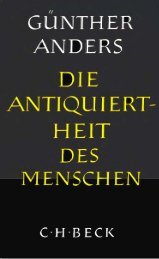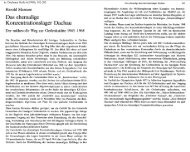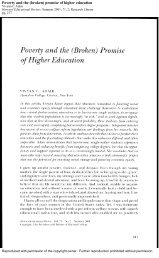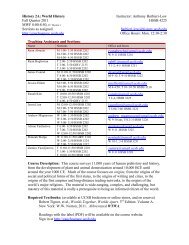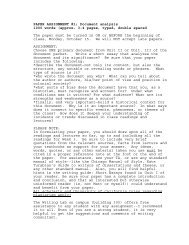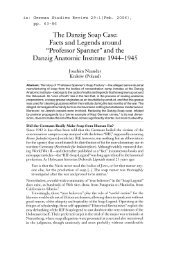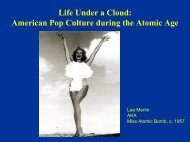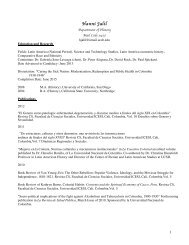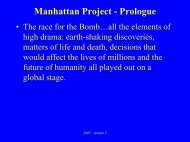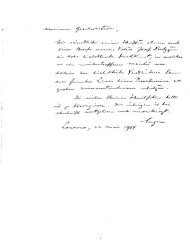The Manhattan Project, 1942-44 - DePa
The Manhattan Project, 1942-44 - DePa
The Manhattan Project, 1942-44 - DePa
Create successful ePaper yourself
Turn your PDF publications into a flip-book with our unique Google optimized e-Paper software.
<strong>The</strong> <strong>Manhattan</strong> <strong>Project</strong>, <strong>1942</strong>-<strong>44</strong><br />
Building an Atomic Infrastructure<br />
• “<strong>The</strong> <strong>Manhattan</strong> <strong>Project</strong> bore no relation to<br />
the industrial or social life of our country; it<br />
was a separate state with…its thousands of<br />
secrets. It had a peculiar sovereignty, one<br />
that could bring about the end, peacefully or<br />
violently, of all other sovereignties.”<br />
– Herbert S. Marks<br />
2005 - lecture 6
<strong>Manhattan</strong> <strong>Project</strong><br />
2005 - lecture 6
<strong>Manhattan</strong> <strong>Project</strong> Scientists:<br />
Soldiers out of Uniform<br />
• <strong>The</strong>ir participation in <strong>Manhattan</strong> <strong>Project</strong> –<br />
<strong>The</strong> single most profound experience in the<br />
history of the American scientific<br />
community.<br />
2005 - lecture 6
Back in the U.S…<br />
• Vannevar Bush and the National Defense Research<br />
Council (NRDC) take over US uranium work. James<br />
Conant (chemist and pres. of Harvard put in charge)<br />
Arthur Compton<br />
V. Bush<br />
Karl Compton<br />
E. Lawrence<br />
J. Conant<br />
A. Loomis<br />
2005 - lecture 6
• 1940-41: Money begins to flow<br />
– July 1940 - $40,000 more put into work<br />
• Efforts directed not for bomb but for Enrico<br />
Fermi’s studies of uranium reactor.<br />
2005 - lecture 6
• By fall of 1941, Compton, Conant,<br />
Lawrence, Bush – encouraged by MAUD<br />
report – urge FDR to undertake large bomb<br />
project.<br />
• FDR separates scientists from policy<br />
decisions.<br />
• FDR (informally) authorizes $1.2 million<br />
and urges crash program.<br />
• December 6, 1941: FDR authorizes the<br />
<strong>Manhattan</strong> Engineering District.<br />
2005 - lecture 6
<strong>Manhattan</strong> <strong>Project</strong> Expands<br />
• After Pearl Harbor, FDR OK’s some $1.2<br />
million to be spent.<br />
• American bomb effort re-named the<br />
<strong>Manhattan</strong> <strong>Project</strong><br />
• Put under U.S. Army control in <strong>1942</strong>.<br />
– Why the Army?<br />
2005 - lecture 6
Questions for the <strong>Manhattan</strong> <strong>Project</strong><br />
and a mission<br />
• Is a chain reaction possible in practice?<br />
• How to produce bomb-grade uranium and<br />
plutonium?<br />
• A successful bomb project – needs<br />
industrial-scale resources, superior<br />
management, and the will to succeed.<br />
2005 - lecture 6
<strong>The</strong> Met Lab<br />
• <strong>The</strong> Metallurgical Laboratory at the<br />
University of Chicago founded early <strong>1942</strong><br />
– Run by Nobel laureate Arthur Compton<br />
– Fermi moves from Columbia to Chicago<br />
• Some of the Met Lab’s goals:<br />
– Prove that a chain reaction is possible<br />
– Develop ways to extract Pu from U<br />
2005 - lecture 6
Fermi and Chicago Pile-1<br />
• Early studies encouraging – probably less<br />
U-235 needed to get a critical mass<br />
• Enrico Fermi leader of group studying chain<br />
reaction.<br />
• Fermi scales up reactor studies.<br />
• By December, <strong>1942</strong> – Fermi & Co. build a<br />
test atomic “pile”<br />
2005 - lecture 6
Stagg Field, Chicago<br />
One of the graphite-uranium layers in CP-1<br />
2005 - lecture 6<br />
Enrico Fermi, <strong>1942</strong>
CP-1<br />
2005 - lecture 6
• James Conant receives<br />
coded message from<br />
Compton:<br />
– “<strong>The</strong> Italian navigator<br />
has landed in the New<br />
World.”<br />
• First controlled<br />
nuclear reaction.<br />
• Produced miniscule<br />
half a watt of energy.<br />
<strong>The</strong> New World<br />
2005 - lecture 6
Szilard<br />
Fermi<br />
Szilard to Fermi: “This will go down as a black day in the history<br />
of mankind…”<br />
2005 - lecture 6
Two weeks after CP-1 debuts…<br />
• FDR approves another $250 million (about<br />
$3 billion today) to scale up to production.<br />
• American expertise in industrial production<br />
to make U-235 and Pu-239.<br />
– This is an area where America excels.<br />
• <strong>The</strong> <strong>Manhattan</strong> <strong>Project</strong> is now less of a<br />
scientific endeavor than massive<br />
engineering effort.<br />
2005 - lecture 6
Building an Atomic Infrastructure<br />
• Niels Bohr (1939): Building an atomic<br />
bomb “can never be done unless you turn<br />
the United States into one huge factory.”<br />
• This becomes the means to the end.<br />
2005 - lecture 6
Managing the <strong>Manhattan</strong> <strong>Project</strong><br />
• <strong>Manhattan</strong> <strong>Project</strong> requires a master<br />
organizer. This is Brig. Gen. Leslie Groves.<br />
• Groves placed in charge of the <strong>Manhattan</strong><br />
<strong>Project</strong> in September <strong>1942</strong>.<br />
• Who is Leslie Groves?<br />
2005 - lecture 6
Gen. Leslie R. Groves… “the angriest<br />
officer in the Army.”<br />
• b. 1896 – d.1970<br />
• College education; Army Corps<br />
of Engineers; in charge of<br />
building the Pentagon.<br />
• His assignment – “Draw up<br />
plans for the organization,<br />
construction, operation and<br />
security of the project, and after<br />
approval, take the necessary<br />
steps to put it into effect.”<br />
2005 - lecture 6
Groves’ Challenges<br />
• Choose industrial sites for<br />
uranium and plutonium<br />
production<br />
• Select industrial<br />
contractors<br />
• Keep schedule<br />
• Maintain security<br />
• Nurture relationship with<br />
scientists<br />
– Groves and J. Robert<br />
Oppenheimer<br />
2005 - lecture 6
Groves’ Genius<br />
• Ability to grasp essentials<br />
• Willingness to take risks<br />
• Ability to amass and apply resources<br />
• Manage the tension between scientists and<br />
military<br />
• Maintain project security<br />
– Compartmentalization, deception (see JRO<br />
letter to LG)<br />
2005 - lecture 6
Building an Atomic Infrastructure<br />
• Groves given incredible latitude and<br />
resources to complete his tasks<br />
• One of the first major tasks – get industrial<br />
scale production of uranium and plutonium<br />
started<br />
• Which to pursue – a uranium or plutonium<br />
bomb?<br />
– Groves: “Both.”<br />
2005 - lecture 6
Building an Atomic Infrastructure<br />
• Groves picks 3 major sites<br />
for building the atomic<br />
bomb<br />
– Oak Ridge, TN – uranium<br />
processing<br />
– Hanford, WA – plutonium<br />
production<br />
– Los Alamos, NM – scientific<br />
research, design, construction,<br />
and testing (operated by Univ.<br />
of Calif.)<br />
2005 - lecture 6
Building an Atomic Infrastructure<br />
Oak Ridge, TN<br />
• Located near Knoxville, TN; sprawling<br />
complex on 59,000 rural acres that Groves<br />
bought<br />
• Groves’ “troops” erect small city of<br />
hundred of buildings employing some<br />
22,000 men and women with its own power<br />
plant.<br />
2005 - lecture 6
Early View of Oak Ridge<br />
2005 - lecture 6
Gaseous diffusion plant; Oak Ridge<br />
$500M; 12,000 workers<br />
2005 - lecture 6
Producing U-235 at Oak Ridge<br />
• Two methods pursued in tandem: gaseous<br />
diffusion and electromagnetic separation.<br />
• As Groves said, “If there is a choice<br />
between two methods, one of which is good<br />
and the other looks promising, then build<br />
both.”<br />
• Both methods based on different<br />
size/weight of U-235 vs. U-238. Goal was a<br />
few ounces of U-235 a day.<br />
2005 - lecture 6
1. Gaseous diffusion done first<br />
– Plant (codename K-25) built at cost of $10.7<br />
billion [2003 dollars]<br />
2. This was then fed into a second stage which<br />
enriched it further<br />
3. Electromagnetic separation (a variation of<br />
what a cyclotron does)<br />
– Plant code-named Y-12 built for $10 billion<br />
2005 - lecture 6
2005 - lecture 6
Electromagnetic Separation<br />
2005 - lecture 6
“Calutron” Operators at Oak Ridge<br />
2005 - lecture 6
“Racetrack” for Separating U-235<br />
2005 - lecture 6
What they want…<br />
2005 - lecture 6
Building an Atomic Infrastructure<br />
Hanford, WA<br />
• Located in desert valley of Washington near<br />
Columbia River<br />
– River was key for cooling reactors and providing power<br />
• Hanford became a sprawling atomic boomtown –<br />
Built and operated by DuPont Chemical<br />
Corporation for $1.<br />
2005 - lecture 6
Life at Hanford<br />
• A story of superlatives – Hanford becomes<br />
fourth largest city in WA while reactors are<br />
built.<br />
– Largest general delivery post office in the<br />
world<br />
– Work week – 54 hours over 6 days<br />
– Meals – 50 tons a day – were 69 cents for all<br />
you could eat.<br />
• Science vs. engineering at Hanford<br />
2005 - lecture 6
Building an Atomic Infrastructure<br />
Hanford, WA<br />
One of three reactor plants built at Hanford<br />
2005 - lecture 6
T Plant, Chemical Separation Building,<br />
Hanford, Washington<br />
2005 - lecture 6
Building an Atomic Infrastructure<br />
Hanford, WA<br />
• Plutonium “bred”at Hanford<br />
– U-238 bombarded with neutrons<br />
– Gradually decays to form Pu-239 (with some<br />
Pu-240 as impurity)<br />
• By 19<strong>44</strong>, Hanford reactors are producing<br />
some 250 megawatts of power (vs. half a<br />
watt two years earlier in Chicago)<br />
2005 - lecture 6
Building an Atomic Infrastructure<br />
• By the end of 19<strong>44</strong>: both uranium and<br />
plutonium suitable for bombs are being<br />
produced at industrial-scale facilities.<br />
• <strong>The</strong> bigger picture…by end of 19<strong>44</strong>,<br />
Germany appears almost<br />
defeated…Question: Why continue with<br />
<strong>Manhattan</strong> <strong>Project</strong>?<br />
– Note: Japanese fleet considered a possible<br />
target as early as 1943.<br />
2005 - lecture 6
Building an Atomic Infrastructure<br />
• <strong>The</strong> bigger picture: Investing several<br />
hundred million dollars into massive<br />
factories producing large amounts of<br />
uranium and plutonium indicated one key<br />
thing:<br />
• <strong>The</strong> US was permanently committing<br />
itself to atomic weapons.<br />
2005 - lecture 6
• Firebombing of Hamburg<br />
(July 1943); 45,000 civilians<br />
killed.<br />
– Stated goal: “To destroy<br />
Hamburg”<br />
– Why? “shortening and winning<br />
the war.”<br />
• One atrocity in escalating<br />
war of atrocities – Bataan,<br />
concentration camps, Soviet<br />
front.<br />
• Dresden, Berlin, Tokyo, etc.<br />
all firebombed.<br />
War Developments<br />
2005 - lecture 6
Meanwhile, on a desert mesa in<br />
New Mexico…<br />
2005 - lecture 6



